SBC Camshafts – A primer
SBC
Camshafts – A primer
Updated
September 16, 2006
By
Jay Knopp – “Sonix”
for
https://www.thirdgen.org
The
following is a basic crash course in camshafts. This was designed to
clarify some of the terminology behind camshafts, and to help give a
basic understanding into the types of camshafts, lifter types, and a
brief view on selection.
Types:
Hydraulic
Flat tappet (aka hydraulic lifter cam)
This is the
factory style for SBC’s from the dawn of time, to ~1987. Good
performance can be achieved, and there is little to no maintenance
required. Limitations are that valve float can occur, due to
“lifter pump up”, limiting your max RPM to around
6500RPM. The tappets, aka lifters, simply have flat bottoms, this
limits the camshafts ramp rates. Flat tappet
Cost is roughly
$120 for the camshaft, $70 for lifters.
Here is a picture
of a flat tappet cam and lifters in operation. You can see the
convexity of the bottom of the lifters, greatly exaggerated for
clarity.
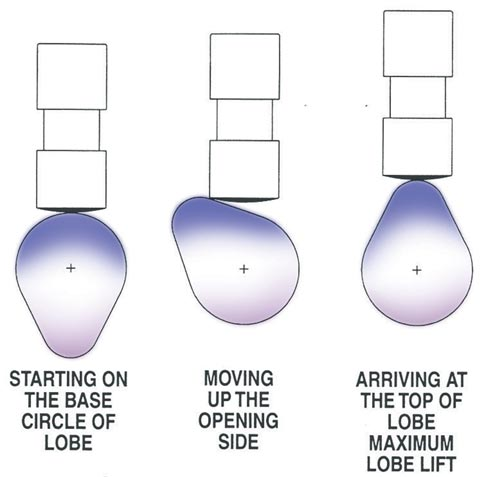
Solid
flat tappet (aka mechanical flat tappet)
This is the same
idea as the hydraulic flat tappet, except the lifters are solid,
rather then filled with oil. This means that your RPM range can be
wider, and you don’t have to worry about valve float at
higher RPM. This style was factory for a few high performance cars
in the late ‘60s, but that’s basically it. Generally
there will be a sharper ramp rate. These cams require periodic
maintenance, as the valve adjustment is not self adjusting like
with a hydraulic lifter, budget re-lashing your valves every oil
change.
Cost is roughly
$140 for the cam, $85 for lifters.
Hydraulic
roller (aka, roller cam)
This is your
factory style cam from 1987 or so onwards. The camshaft has steeper
ramp rates, giving you more lift for a given duration. The lifters
have a small roller on the underside, which makes it more forgiving
to harsh ramp rates. These cams tend to last longer, and have less
friction, therefore giving more power, and are overall better than
a flat tappet cam.
Cost is roughly
$250 for the cam, $240 for lifters.
Retrofit
roller
This is how a
person goes about putting a roller camshaft, in an older, flat
tappet style block. A roller block (1987 and on), will have tapped
holes in the lifter valley, whereas the flat tappet block will not.
That’s your dead give away. If you want to use a roller cam
in your flat tappet block, you need to buy a Retrofit roller
camshaft, and retrofit roller lifters. More on this in the
definitions section.
Cost is roughly
$250 for the cam, $450 for the lifters
Solid
roller (aka mechanical roller cam)
This style was
never used from factory. This is generally a race only type of
camshaft. The same rules apply here as going from hydraulic flat
tappet, to solid flat tappet. Due to the roller lifters, and solid
lifter style, very large lift can be achieved, .700” lift is
not uncommon. Solid roller lifters do not have provisions to oil
the roller axles, this is not a problem during racing, as splash
oiling will suffice, but if you wanted to use a solid roller on the
street, special grooved rollers can be used, or you can groove your
lifter bores (Comp cams make a tool for this).
Cost is roughly
$250 for the cam, $350 for the lifters
General
flat tappet notes:
All flat tappet
cams require a break in procedure. Check with your cam manufacturer
for more information.
Flat tappet
camshaft lobes are ground with a slight angle, such that the
camshaft is automatically held in place while running. No cam
button is required.
This is a picture
of run of the mill hydraulic flat tappets. The rightmost tappet
(lifter) shows it’s bottom surface, this is the part that
rides on the camshaft.
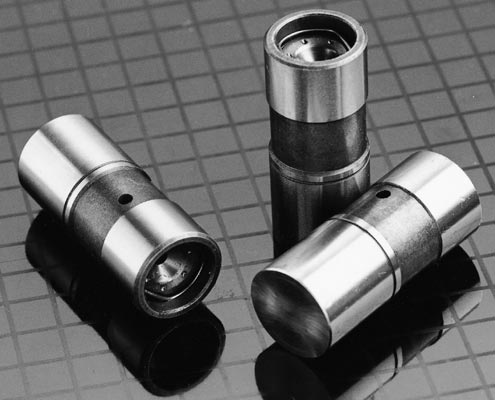
After break in, a
flat tappet cam is married to its lifters. You cannot move lifters
between different bores, and you cannot use those lifters on a
different cam. The lifters either stay with that lobe, or get
thrown out, period.
The following
picture shows a flat tappet camshaft in the front, and a roller
camshaft in the rear.

General
roller cam notes:
A roller cam needs
no break in procedure
Roller lifters are
NOT designed to rotate in their bores while the motor is running.
All roller lifters must have some provision to keep them from
rotating. Common methods are; dog-bone & spiders as the factory
style, with link bars being the common aftermarket “Retrofit”
style.
A factory spider
and dog bones are shown here.

Roller lifters are
re-useable with different camshafts, assuming they aren’t
visually damaged.
When upgrading to
a roller cam, using a flat tappet block, you must have a method of
keeping the camshaft from walking forward, commonly a cam button,
with a strengthened timing chain cover. Also a method to keep the
roller lifters from rotating. Pushrods on flat tappet, and roller
motors are also a different length
This picture shows
a grooved roller lifting resting on a roller camshaft lobe.
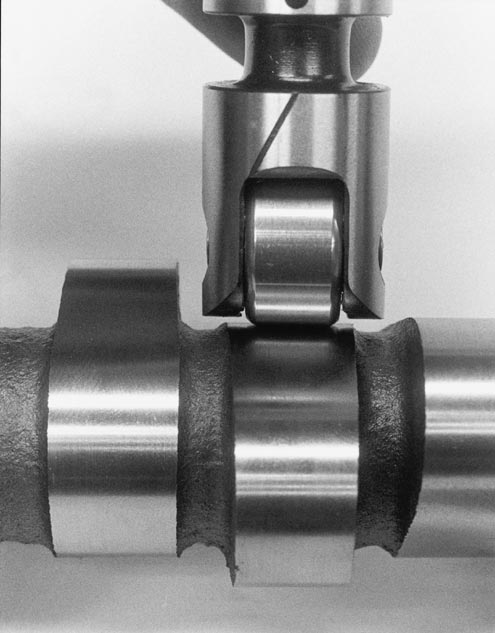
Definitions
of terms
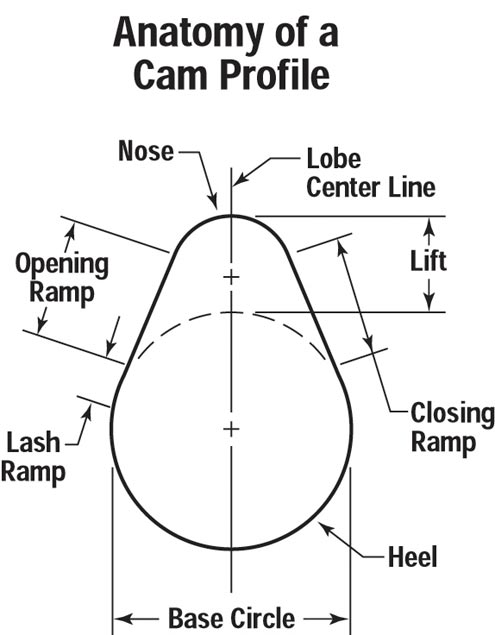
Advertised
Duration – This is the time, in degrees, where the lifter
is off the base circle of the camshaft. You can also think of it as
how long your valve is open. Higher duration means the engine will
have its powerband higher up in the RPM range. Different camshaft
manufacturers use a different measurement, ie, Comp Cams says that
Advertised duration is when the lifter is .006” off the base
circle, where Crane cams says .004” etc. This means that if
comp and crane both made an identical camshaft, the crane would have
a larger advertised duration. This is a poor method of comparing
camshafts between brands. Expect a number like 275*. Something like
282*/292* means 282 intake duration, 292 exhaust duration.
Split
pattern, aka dual pattern – This is when a camshaft has
unequal intake and exhaust lobes. Some cams have a single pattern,
ie, 264/264* duration, where a dual pattern would have 264*/274* for
example. The dual pattern usually has a longer exhaust duration, and
more exhaust lift. This is the make up for the fact that factory
cylinder heads, and most aftermarket ones have far less exhaust port
flow, so more cam timing is needed to make up for it. Most times a
split pattern makes more power on stock heads, or mild aftermarket
heads. High end CNC machined race heads would probably benefit from a
single pattern.
Duration
@ .050” – This is the duration when your lifter is
.050” off your base circle of the camshaft. This number is best
used to compare camshafts between brands. Expect a number like 220*.
A “small”, or stock cam might be in the 202 range, where
as a full blown race cam would be in the 260* range.
Ramp
rate – An easy way to tell how fast a camshafts ramp rate
is to take the advertised duration, and subtract the duration @
.050”. The larger the number, the slower the ramp rate, the
more gently the cam lifts the valve. Slower ramp rates usually tend
to have higher advertised duration, with less duration @.050”,
and less lift. This tends to give the “big cam feel” of
large advertised duration, without the big cam power of high lift.
These cams are easier on valvetrain, at the cost of performance and
mileage. Solid roller cams will have the shortest ramp rate, and old
hydraulic flat tappet grinds will have the largest ramp rate.
Here
is an illustration showing how roller tappets give more duration at a
given lift, or more lift at a given during, depending on how you like
to look at it. You can see the steeper ramp rate on the roller lobe.
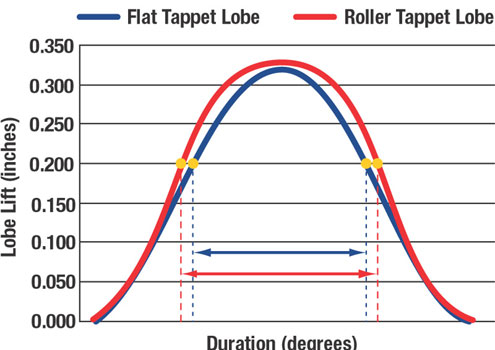
Power
band – This term is somewhat loosely used. Most cam
manufacturers will list a “guesstimated power range” with
a cam. This is usually assuming many things, such as it having 350
cubic inches, a basic dual plane intake manifold, etc. If you have a
larger motor (400cid for example), it “eats up the cam”,
hence the powerband is lower. A smaller motor (305 for example) will
shift the powerband higher. Other factors effect the powerband as
well, so paper specs will be a guess at best. The true way of finding
YOUR power band is to dyno test the engine.
LSA
– Lobe Seperation angle – This is somewhat
complicated, but it’s basically how many degrees of separation
there is between the lobes (duh). The shorter the number, the more
overlap there is. This overlap has the same effect as having a
larger duration cam. A shorter LSA, (say 106), will have a peakier
power band, and a rougher idle. A larger LSA (say 114), will have a
flatter torque curve, and a smoother idle. The larger LSA is
recommended for computer controlled vehicles, like TPI motors, as it
makes it easier (or possible) to tune for.
Lift
– This is how far the valve gets lifted. The more lift, the
more airflow (assuming your heads can support it), so the more power.
Rarely, a cam will give “lobe lift”, this is the base
lift your cam gives. This might be in the low .3xx” range. Most
of the time however, lift is measured with an assumed 1.5 ratio
rocker arm. Lift might be .460”. If you go to a 1.6 ratio
rocker, you will get 1.6/1.5 or 6.6666% more lift. This artificially
increases your duration, but that’s another story. The angle
shown in the following picture is the duration of the lobe, since the
camshaft spins at half the rate of the crankshaft, this lobe would be
a 282* lobe.

Retrofit
roller – This is what you call it, when you put a roller
cam in an older non roller motor. In order to do this, you need to
use a retrofit roller camshaft, and retrofit roller lifters. A
retrofit roller camshaft differs from a stock camshaft, in that has
no provision for a thrust button. Retrofit roller lifters, do not
require a spider in the lifter valley, they are simple linked in
pairs, via link bars, which keep them from rotating. They are also
longer than stock roller lifters, meaning you can use flat tappet
length pushrods. These are extremely expensive, hence the reason why
retrofit roller setups are not very common.
Camshaft
materials – Camshafts are made of different materials,
depending on the style of the cam. A flat tappet cam, will generally
be made of cast iron. Roller camshafts, are typically made of cast
steel, or can be made from a billet. This is one reason why roller
camshafts are more expensive. Pay attention to this when you are
selecting your distributor gear, some aftermarket billet roller
camshafts require the use of a softer brass distributor gear.
Brands
– Without showing any brand loyalty, here is a list of
camshaft manufacturers to consider:
Competition
cams
Crane
Cams
Lunati
Summit
Erson
Edelbrock
Iskenderian
Picking
the RIGHT cam
CR
requirements – The bigger the cam (duration), the more
compression ratio it needs to work right. A low CR motor, will be
extremely sluggish at low RPMs, when used with a “big”
cam. Likewise, a small cam in a high CR motor, will ping like crazy,
all the time, due to excessively high dynamic compression ratio. Here
is a ROUGH guide:
| Intake Duration @ .050 | Recommended CR |
| 210 | 8.5-9.5:1 |
| 210-220 | 9-9.5:1 |
| 220-230 | 10:1 |
| 230-240 | 10.5-11:1 |
| 240 and up | 11:1 or greater |
Gearing
requirements – A larger cam, will give you more top end
power at the expensive of less low end power. This means you want
your car to have “more gear”, to get it rolling, and into
the higher RPM sooner. So with a larger cam, you want “steeper”
gears. 3.73 gears, match up well with a Compxe274, as an example.
The right gear ratio to pick for ¼ mile racing is more
complex, as you want your car to run through the traps at peak HP,
however for street use, that isn’t a necessary consideration.
Convertor
Stall speed – For those of you forsaken with an automatic
transmission, the stall speed of your torque convertor is another
factor to consider. This goes hand in hand with the abovementioned
point of gearing. You want your car to get into it’s powerband
sooner, so if your powerband is 2500-6500RPM, a 1700RPM stall speed
is inadequate, 2500RPM would be better. True racers can dyno their
motor, and help them pick the right torque convertor, the rest of us
just guess, or ask a reputable torque convertor manufacturer.
Power
brakes – A large cam has another side effect – power
brakes. Due to the fact that a larger than stock cam will produce
less vacuum at idle, it will give less power to your power brake
booster. There is no set in stone size of cam where this happens, but
as a ballpark, over 230* @.050” duration in a 350 CID, vacuum
will start to get dicey. Tuning skill can go a long way here, some
people have trouble with a 225* cam, and others can make a 240* cam
work.
